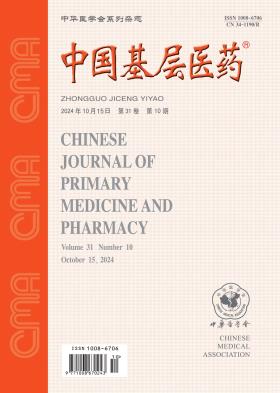Efficacy and safety of Yinchenhao Decoction combined with blue light irradiation in the treatment of neonatal pathological jaundice
引用次数: 0
Abstract
Objective To explore the efficacy and safety of Yinchenhao Decoction combined with blue light irradiation in the treatment of neonatal pathological jaundice. Methods From January 2018 to October 2018, a total of 94 neonates with pathological jaundice admitted to our hospital were divided into the control group and the observation group, with 47 cases in each group.On the basis of conventional treatment, the control group was given blue light irradiation treatment, while the observation group was treated with Yinchenhao Decoction on the basis of the control group.The changes of TBIL, UCB, TBA and HS-CRP levels, β-GD levels, clinical efficacy and incidence of adverse events were compared between the two groups after 7 days of treatment. Results After 7 days of treatment, the TBIL, UCB, TBA and HS-CRP levels in the observation group were (116.4±6.9)μmol/L, (153.6±8.2)μmol/L, (8.3±1.3)μmol/L, (4.9±0.6)mg/L, respectively, which were lower than those in the control group [(153.6±8.2)μmol/L, (249.3±42.3)μmol/L, (25.9±2.9)μmol/L, (18.3±0.5)mg/L] (t=15.851, 20.329, 9.624, 7.508, all P<0.05). The β-GD level reduced more significant in the observation group, which in both two groups were decreased after treatment (all P<0.05). The total effective rate of the observation group was 97.9%(46/47), which was significantly higher than that of the control group[85.1%(40/47)], and the total incidence of adverse reactions in the observation group was 4.3%(2/47), which was significantly lower than that in the control group[29.8%(17/47)], the differences were statistically significant(χ2=11.562, 14.605, all P<0.01). Conclusion Yinchenhao Decoction combined with blue light irradiation is effective in the treatment of neonatal pathological jaundice, possibly by affecting β-GD levels.In addition, it can significantly reduce the incidence of adverse reactions in children, with better efficacy and higher safety.It is worthy of clinical reference and promotion. Key words: Jaundice, neonatal; Drugs, Chinese herbal; Balneology; Color therapy; Bilirubin; Bile acids and salts; C-reactive protein; Aldehyde dehydrogenase; Comparative study银陈好汤联合蓝光照射治疗新生儿病理性黄疸的疗效及安全性观察
目的探讨银陈濠汤联合蓝光照射治疗新生儿病理性黄疸的疗效和安全性。方法2018年1月~ 2018年10月,将我院收治的病理性黄疸新生儿94例分为对照组和观察组,每组47例。对照组患者在常规治疗的基础上给予蓝光照射治疗,观察组患者在对照组治疗的基础上给予银陈濠汤治疗。比较两组患者治疗7 d后TBIL、UCB、TBA、HS-CRP水平、β-GD水平、临床疗效及不良事件发生率的变化。结果治疗7 d后,观察组患者TBIL、UCB、TBA、HS-CRP水平分别为(116.4±6.9)μmol/L、(153.6±8.2)μmol/L、(8.3±1.3)μmol/L、(4.9±0.6)mg/L,均低于对照组[(153.6±8.2)μmol/L、(249.3±42.3)μmol/L、(25.9±2.9)μmol/L、(18.3±0.5)mg/L] (t=15.851、20.329、9.624、7.508,P均<0.05)。观察组患者β-GD水平降低更为显著,治疗后两组患者β-GD水平均降低(均P<0.05)。观察组总有效率为97.9%(46/47),显著高于对照组的85.1%(40/47);观察组总不良反应发生率为4.3%(2/47),显著低于对照组的29.8%(17/47),差异均有统计学意义(χ2=11.562、14.605,均P<0.01)。结论银陈好汤联合蓝光照射治疗新生儿病理性黄疸有效,可能与影响β-GD水平有关。此外,它可以显著降低儿童不良反应的发生率,疗效更好,安全性更高。值得临床参考和推广。关键词:黄疸;新生儿;药物,中草药;浴疗学;色彩疗法;胆红素;胆汁酸和盐;c反应蛋白;醛脱氢酶;比较研究
本文章由计算机程序翻译,如有差异,请以英文原文为准。
求助全文
约1分钟内获得全文
求助全文
来源期刊
CiteScore
0.10
自引率
0.00%
发文量
32251
期刊介绍:
Since its inception, the journal "Chinese Primary Medicine" has adhered to the development strategy of "based in China, serving the grassroots, and facing the world" as its publishing concept, reporting a large amount of the latest medical information at home and abroad, prospering the academic field of primary medicine, and is praised by readers as a medical encyclopedia that updates knowledge. It is a core journal in China's medical and health field, and its influence index (CI) ranks Q2 in China's academic journals in 2022. It was included in the American Chemical Abstracts in 2008, the World Health Organization Western Pacific Regional Medical Index (WPRIM) in 2009, and the Japan Science and Technology Agency Database (JST) and Scopus Database in 2018, and was included in the Wanfang Data-China Digital Journal Group and the China Academic Journal Comprehensive Evaluation Database.

 求助内容:
求助内容: 应助结果提醒方式:
应助结果提醒方式:


